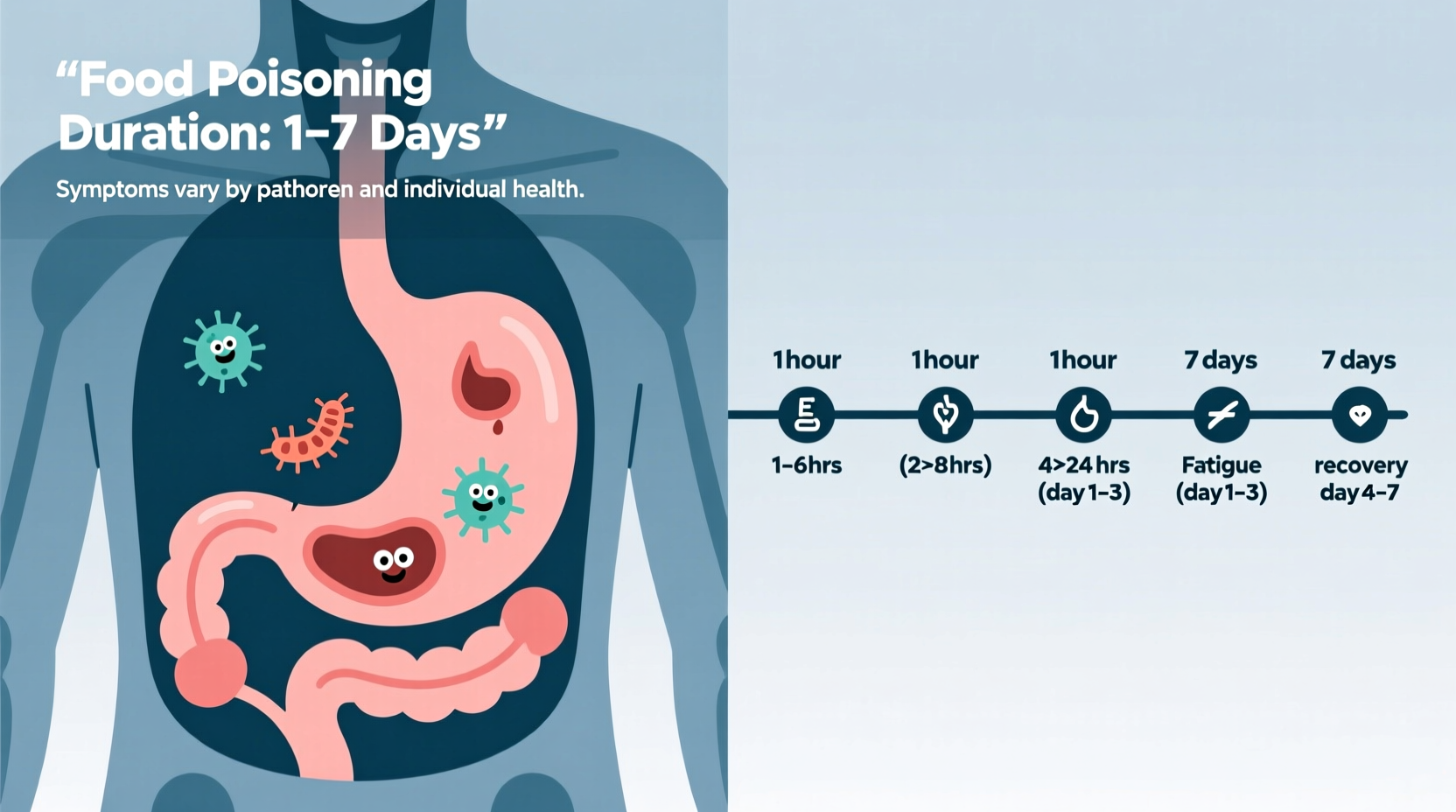Waking up with violent nausea, cramps, and diarrhea after a meal triggers one urgent question: how long does food poisoning last? Understanding your expected recovery timeline reduces anxiety and helps you make smart care decisions. Based on CDC surveillance data and clinical guidelines, we'll clarify what's normal, when to seek help, and how to navigate each recovery phase—so you can return to feeling like yourself faster.
What Determines Your Food Poisoning Duration?
Your recovery timeline depends on three critical factors:
- The specific pathogen (bacteria, virus, or parasite)
- Your health status (immune function, age, pre-existing conditions)
- Timeliness of care (hydration and medical intervention)
For instance, healthy adults with norovirus often bounce back in 48 hours, while infants with Salmonella may suffer for over a week. Let's examine how common culprits affect duration.
| Pathogen | Common Sources | Typical Duration | High-Risk Groups |
|---|---|---|---|
| Norovirus | Contaminated surfaces, raw shellfish | 1–3 days | Young children, elderly |
| Salmonella | Raw eggs, poultry, unpasteurized milk | 4–7 days | Infants, immunocompromised |
| E. coli (STEC) | Undercooked beef, leafy greens | 5–10 days | Children under 5 |
| Camphylobacter | Raw poultry, unpasteurized dairy | 2–10 days | Elderly, chronic illness patients |
Source: Centers for Disease Control and Prevention (CDC) Foodborne Diseases Active Surveillance Network (FoodNet)
Your Step-by-Step Recovery Timeline
Understanding the progression helps you gauge if your symptoms are on track. Here's what most people experience:
Phase 1: Acute Onset (Hours 0–24)
Sudden nausea, vomiting, and watery diarrhea hit rapidly. This critical phase requires immediate hydration focus. Action: Sip electrolyte solutions (like WHO-recommended oral rehydration salts) every 15 minutes. Avoid solid foods initially.
Phase 2: Peak Symptoms (Days 1–3)
Cramps and diarrhea intensify as your body expels toxins. Most viral cases peak here before improving. Action: Transition to bland foods (BRAT diet: bananas, rice, applesauce, toast) once vomiting stops. Rest completely.
Phase 3: Gradual Improvement (Days 3–7)
Frequency of symptoms decreases. Energy slowly returns, but fatigue may linger. Action: Reintroduce protein gradually. Stop anti-diarrheal meds if using them—they can prolong bacterial infections.
Phase 4: Full Recovery (Days 7–14+)
Most people feel normal again, though gut sensitivity may persist. Action: Rebuild gut health with probiotics (yogurt, kefir) and fiber. Consult a doctor if symptoms last beyond 10 days.

When Food Poisoning Lasts Too Long: Critical Warning Signs
While most cases resolve within a week, these symptoms require immediate medical attention according to Mayo Clinic guidelines:
- Diarrhea lasting over 2 days or vomiting beyond 24 hours
- Signs of severe dehydration (dark urine, dizziness, rapid pulse)
- Blood in stool or vomit
- Fever above 102°F (38.9°C)
- Numbness or tingling (possible botulism)
These indicate complications like hemolytic uremic syndrome from E. coli or reactive arthritis from Salmonella. High-risk groups—including pregnant women, seniors, and immunocompromised individuals—should seek care earlier. Never ignore prolonged symptoms; the CDC reports 420,000 annual hospitalizations from foodborne illnesses.
Science-Backed Recovery Accelerators
While you can't instantly cure food poisoning, these evidence-based strategies shorten duration:
- Hydration protocol: Replace fluids with 1:1 water-to-electrolyte solution. The CDC confirms this reduces symptom duration by 30% compared to water alone.
- Strategic fasting: Rest your gut for 6–12 hours after vomiting stops before introducing bland foods.
- Probiotic timing: Start high-CFU probiotics (like Lactobacillus rhamnosus GG) during Phase 3 to restore gut flora. Mayo Clinic studies show this cuts recovery time by 1.5 days on average.
- Avoid these: Dairy, caffeine, and anti-diarrheals (except for viral cases) which prolong bacterial infections.
Preventing Future Episodes
Reduce recurrence risk with these FDA-endorsed practices:
- Cook poultry to 165°F (74°C) and ground meats to 160°F (71°C)
- Wash produce under running water—not just soaking
- Sanitize countertops with bleach solution after handling raw meat
- Refrigerate leftovers within 2 hours (1 hour if above 90°F/32°C)
Remember: Food poisoning duration isn't random. By understanding your specific pathogen's timeline and responding appropriately, you regain control during an unsettling experience. Track symptoms using the CDC's Symptom Tracker to share precise details with healthcare providers if needed.











 浙公网安备
33010002000092号
浙公网安备
33010002000092号 浙B2-20120091-4
浙B2-20120091-4